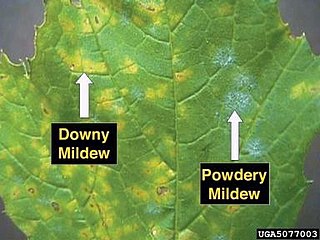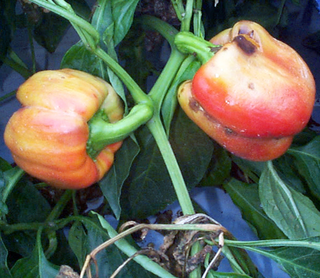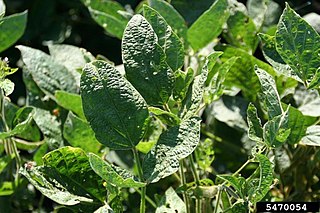
Variegation is the appearance of differently coloured zones in the foliage, flowers, and sometimes the stems and fruit of plants, granting a speckled, striped, or patchy appearance. The colors of the patches themselves vary from a slightly lighter shade of the natural coloration to yellow, to white, or other colors entirely such as red and pink. This is caused by varying levels and types of pigment, such as chlorophyll in leaves. Variegation can be caused by genetic mutations affecting pigment production, or by viral infections such as those resulting from mosaic viruses. Many plants are also naturally variegated, such as Goeppertia insignis. Most of these are herbaceous or climbing plants, and are most often species native to tropical rainforests.

Downy mildew refers to any of several types of oomycete microbes that are obligate parasites of plants. Downy mildews exclusively belong to the Peronosporaceae family. In commercial agriculture, they are a particular problem for growers of crucifers, grapes and vegetables that grow on vines. The prime example is Peronospora farinosa featured in NCBI-Taxonomy and HYP3. This pathogen does not produce survival structures in the northern states of the United States, and overwinters as live mildew colonies in Gulf Coast states. It progresses northward with cucurbit production each spring. Yield loss associated with downy mildew is most likely related to soft rots that occur after plant canopies collapse and sunburn occurs on fruit. Cucurbit downy mildew only affects leaves of cucurbit plants.

A leaf spot is a limited, discoloured, diseased area of a leaf that is caused by fungal, bacterial or viral plant diseases, or by injuries from nematodes, insects, environmental factors, toxicity or herbicides. These discoloured spots or lesions often have a centre of necrosis. Symptoms can overlap across causal agents, however differing signs and symptoms of certain pathogens can lead to the diagnosis of the type of leaf spot disease. Prolonged wet and humid conditions promote leaf spot disease and most pathogens are spread by wind, splashing rain or irrigation that carry the disease to other leaves.

Hosta is a genus of plants commonly known as hostas, plantain lilies and occasionally by the Japanese name gibōshi. Hostas are widely cultivated as shade-tolerant foliage plants. The genus is currently placed in the family Asparagaceae, subfamily Agavoideae, and is native to northeast Asia. Like many "lilioid monocots", the genus was once classified in the Liliaceae. The genus was named by Austrian botanist Leopold Trattinnick in 1812, in honor of the Austrian botanist Nicholas Thomas Host. In 1817, the generic name Funkia was used by German botanist Kurt Sprengel in honor of Heinrich Christian Funck, a collector of ferns and alpines; this was later used as a common name and can be found in some older literature.

Lettuce mosaic virus (LMV) is a typical potyvirus, which causes one of the major virus diseases of lettuce crops worldwide.

Aster yellows is a chronic, systemic plant disease caused by several bacteria called phytoplasma. The aster yellows phytoplasma (AYP) affects 300 species in 38 families of broad-leaf herbaceous plants, primarily in the aster family, as well as important cereal crops such as wheat and barley. Symptoms are variable and can include phyllody, virescence, chlorosis, stunting, and sterility of flowers. The aster leafhopper vector, Macrosteles quadrilineatus, moves the aster yellows phytoplasma from plant to plant. Its economic burden is primarily felt in the carrot crop industry, as well as the nursery industry. No cure is known for plants infected with aster yellows. Infected plants should be removed immediately to limit the continued spread of the phytoplasma to other susceptible plants. However, in agricultural settings such as carrot fields, some application of chemical insecticides has proven to minimize the rate of infection by killing the vector.
Cercosporella rubi is a plant pathogenic fungus which causes blackberry rosette, a disease that is also known as double blossom or witches' broomof blackberry. In infected plants, the symptoms that C. rubi causes are double blossoms as well as witches' brooms. Diseased canes do not produce fruit, and as a result, this pathogen poses one of the largest threats to commercial blackberry production. The disease is most prevalent in the southeast United States.
Bean pod mottle virus, or BPMV, is a species of plant pathogenic virus in the family Secoviridae. It is known to infect soybean crops.

Cucumber mosaic virus (CMV) is a plant pathogenic virus in the family Bromoviridae. This virus has a worldwide distribution and a very wide host range, having the reputation of the widest host range of any known plant virus. It can be transmitted from plant to plant both mechanically by sap and by aphids in a stylet-borne fashion. It can also be transmitted in seeds and by the parasitic weeds, Cuscuta sp. (dodder).

Pepper mild mottle virus (PMMoV) is a plant pathogenic virus that occurs worldwide on species of field grown bell, hot and ornamental pepper species. It is caused by members of the plant virus genus Tobamovirus—otherwise known as the tobacco mosaic virus family. Tobamovirus are viruses that contain positive sense RNA genomes that infect plants. Symptoms of the disease vary depending on the cultivar. Typical symptoms include the chlorosis of leaves, stunting, and distorted and lumpy fruiting structures. The virus is spread by mechanical transmission and infected seeds. Avoidance is the best means of controlling the disease because once a plant is infected it cannot be treated. Only seeds that have been tested and treated for the pathogen should be planted.

Prunus necrotic ringspot virus (PNRSV) is a plant pathogenic virus causing ring spot diseases affecting species of the genus Prunus, as well as other species such as rose and hops. PNRSV is found worldwide due to easy transmission through plant propagation methods and infected seed. The virus is in the family Bromoviridae and genus Ilarvirus. Synonyms of PNRSV include European plum line pattern virus, hop B virus, hop C virus, plum line pattern virus, sour cherry necrotic ringspot virus, and peach ringspot virus.

Soybean mosaic virus (SMV) is a member of the plant virus genus Potyvirus. It infects mainly plants belonging to the family Fabaceae but has also been found infecting other economically important crops. SMV is the cause of soybean mosaic disease that occurs in all the soybean production areas of the world. Soybean is one of the most important sources of edible oil and proteins and pathogenic infections are responsible for annual yield losses of about $4 billion in the United States. Among these pathogens, SMV is the most important and prevalent viral pathogen in soybean production worldwide. It causes yield reductions of about 8% to 35%, but losses as high as 94% have been reported.
Strawberry foliar nematode, or strawberry crimp nematode, is a disease caused by Aphelenchoides fragariae, a plant pathogenic nematode. It is common in strawberries and ornamental plants and can greatly affect plant yield and appearance, resulting in a loss of millions of dollars of revenue. Symptoms used to diagnose the disease are angular, water soaked lesions and necrotic blotches. Aphelenchoides fragariae is the nematode pathogen that causes the disease. Its biological cycle includes four life stages, three of which are juvenile. The nematode can undergo multiple life cycles in one growing season when favorable conditions are present. The crowns, runners, foliage, and new buds of the plant via stylet penetration or through the stomata can be infected. The best management practices for this disease are sanitation, prevention of induction of the pathogen to the environment, and planting clean seed or starter plants.
Alternanthera mosaic virus (AltMV) is a plant pathogenic virus. AltMV belongs to the virus genus Potexvirus and the virus family Alphaflexiviridae.

Blueberry shoestring virus (BBSSV) is a disease-causing virus that is commonly transmitted by the aphid vector, Illinoia pepperi. The blueberry shoestring virus disease is very prominent in highbush and lowbush blueberry plants in the northeastern and upper Midwest of the United States. Symptoms can vary significantly depending on the environment, but the most common disease symptoms are reddish streaking on young stems, reduced vigor and strap-shaped leaves. The blueberry shoestring virus disease can be managed by eliminating the aphid vector through the use of biological, chemical or cultural controls. In severe cases, the disease leads to an extensive loss of yield and marketable fruit.

Common spot of strawberry is one of the most common and widespread diseases afflicting the strawberry. Common spot of strawberry is caused by the fungus Mycosphaerella fragariae. Symptoms of this disease first appear as circular, dark purple spots on the leaf surface. Mycosphaerella fragariae is very host-specific and only infects strawberry.
Blueberry shock virus (BlShV) is an Ilarvirus belonging to the Bromoviridae family. The Bromoviridae family contains single-stranded, positive-sense RNA viruses. Virus particles are icosahedral and 30 nm in diameter. Blueberry shock virus causes shock of blueberries in Oregon, Washington, and British Columbia. It gets its name because plants are shocked by the initial infection, meaning the flowers and foliage blight and wilt in the early spring, right when the plant is in full bloom. BIShV was first discovered in a blueberry field containing highbush blueberry in Washington in 1991. It continued to spread to Oregon, Washington and British Columbia since that time. In 2009, the disease was found in a western Michigan field, and may be preset in Pennsylvania as of 2011. Since its discovery, eradication is in progress to eliminate the disease and reduce loss of yield from it.
Sudden death syndrome (SDS), a disease in soybean plants, quickly spread across the southern United States in the 1970s, eventually reaching most agricultural areas of the US. SDS is caused by multiple Fusarium fungi in the Fusariumsolani complex. Fusarium virguliforme is the sole causal agent in North America. In South America, Fusarium brasiliense, F. cuneirostrum, F. tucumaniae, and F. virguliforme are all causal agents. Losses could exceed hundreds of millions of dollars in US soybean markets alone making it one of the most important diseases found in Soybeans across the US.

Viral diseases of potato are a group of diseases caused by different types of Viruses that affect potato crops worldwide and, although they do not affect human or animal health since they are viruses that only infect vegetables, they are a source of great economic losses annually. About 28 viruses have been reported infecting potato crops. However, potato virus X (PVX), potato virus Y (PVY), and potato leafroll virus (PLRV) are the most important viruses worldwide. Some others are of economic importance only in some regions. Such is the case of potato virus M (PVM) in some Asian and European countries.














